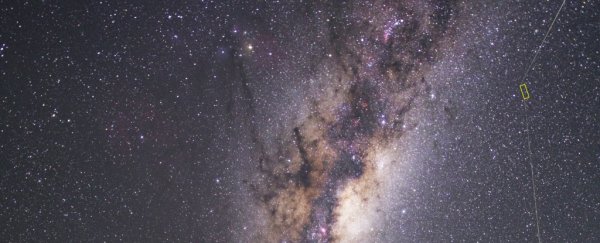Whenever we hear of stars discovered that formed just after the Big Bang, they're very far away, in the far reaches of the visible Universe. But now astronomers have spotted something new: a star that's around 13.5 billion years old, right here in our own Milky Way galaxy.
It's called 2MASS J18082002–5104378 B, and it could be one of the oldest stars in the Universe.
The smoking gun is its metal content. In the very early Universe, there were no metals. They were forged in the hearts of the first generations of stars, which spewed them forth into space upon their violent messy deaths.
This material was then mixed up in the formation of new stars, with each subsequent generation growing richer and richer in metals. The younger the star, the greater the metal content, or metallicity. (The Sun is thought to be around 100 generations from the Big Bang.)
2MASS J18082002–5104378 B has the lowest metallicity of any star ever discovered - only about 10 percent of the metallicity of Earth. Its discovery could mean that the star-dense disc of our galaxy is much older than the 8-10 billion years previously estimated.
And it's tiny - only about 10 percent of the mass of the Sun, right on the edge of the lower limit for hydrogen burning.
"We've never discovered a star so low mass and made of so few grams of metals," astrophysicist Andrew Casey of Monash University in Australia told ScienceAlert.
"This discovery tells us that the very first stars in the Universe didn't have to all be massive stars that died long ago. These ancient stars could form from very small amounts of material, which means some of those relics from soon after the Big Bang could still exist today. That gives us a new viewpoint for star formation in the early Universe!"
Its incredibly small size is how 2MASS J18082002–5104378 B managed to remain undetected for so long, even though it's right here in the Milky Way: it's incredibly faint.
The only reason it was spotted was because it has a binary companion. When astronomers were studying this star, they noticed the faint motion of 2MASS J18082002–5104378 B.
Closer spectroscopic analysis revealed its record-breaking low metallicity, and analysis of its orbit in the Milky Way's thin disc - the star-dense plane of rotation - revealed that it is native to the Milky Way.
Its very presence challenges popular notions of what a very old star looks like. They're not all huge, far away, and likely long dead and gone by now - a view held by scientists as late as the 1990s.
In fact, according to calculations, a tiny star could conceivably live for trillions of years.
"Massive stars 'live fast and die young', but less massive stars - say 20 percent lighter than our Sun - can easily live for 13 billion years," Casey said.
"The problem is that astronomers have long-believed that the first stars in the Universe were massive, and therefore none of them should survive until the present day. This discovery helps change all that: it shows that ancient stars can be very low mass, which implies that some of the oldest stars in the Universe may still be around today."
There are a few other ancient grandpa stars wandering around the Milky Way, such as the red giant HE 1523-0901, out in the galactic halo, or the mysterious Methuselah Star, the age of which has been calculated to be 14.5 billion years (which contradicts the age of the Universe, but is not entirely crazy).
But in terms of small size and low metallicity, 2MASS J18082002–5104378 B outstrips them all. Its composition is much closer to the material that filled the Universe after the Big Bang, before it was converted by a few generations of stars.
And because it's so small and faint and hard to see, it's possible that there are many more small and faint metal-free stars out there. The discovery rate is, as Casey put it, "vanishingly low," but the existence of 2MASS J18082002–5104378 B presents a very good theoretical and observation reason to believe that others exist, too.
"We really need to just keep searching for ancient-looking stars like this system," he said.
"These stars are extremely rare - it's much like finding a needle among an acre of haystacks. But with huge amounts of data from ground-based and space-based telescopes, the future looks good: we are closer than ever to understanding how stars formed in the early Universe."
The team's research is due to be published in the Astrophysical Journal, and can be read in full on pre-print resource arXiv.
Editor's note (7 August 2019): An earlier version of this article incorrectly stated that the Sun is 100,000 generations removed from the Big Bang. In reality, it is thought to be approximately 100 generations. We apologise for the error and have now amended it.
